Development of an Analytical Method to Determine Chromium, Iron, Nickel, and Zinc in Mouthwash by ICP-OES and Assessment of Possible Metal Migration from Stainless Steel
Special Issues
A simple analytical method, requiring no sample pretreatment, was developed for determination of chromium, iron, nickel, and zinc in mouthwash by inductively coupled plasma‒optical emission spectrometry (ICP-OES). This method allowed the study of potential migration by iron, chromium, and nickel from stainless steel containers.
Mouthwash is a commonly used oral care product. Because of its composition, it is considered a complex matrix for elemental analysis. This work describes a simple analytical method, requiring no sample pretreatment, for determination of chromium, iron, nickel, and zinc in mouthwash by inductively coupled plasma optical emission spectrometry (ICP-OES). To study the possible matrix effect on the calibration, a comparison was made between calibrations by matrix-matched and external standards. Excellent detection limits were obtained for chromium, iron, nickel, and zinc (16.0, 23.0, 5.0, and 7.0 µg/L, respectively). In all of the strategies that were used, the linear range of the calibration curve was 30.0 µg/L to 9.0 mg/L (a wide linear range) with a coefficient of determination (R2) > 0.9900. The proposed method was employed both in the determination of zinc, present as an ingredient in certain mouthwashes, and in the evaluation of possible migration by iron, chromium, and nickel from the stainless steel.
The use of mouthwash for oral care is a common practice. Ease of use, coupled with their effectiveness in preventing and controlling common mouth diseases, generates great demand for these products (1).
Mouthwashes containing zinc salts (such as chloride, citrate, and lactate), mainly associated with other actives such as chlorhexidine and cetylpyridinium chloride, have been shown to be effective in combating halitosis (2-4). In addition, zinc has low toxicity and does not stain teeth (5).
Metal migration to mouthwashes is reported in the literature (6,7), focusing on the corrosion studies of orthodontic appliances (also produced in stainless steel). Elemental analysis is usually performed by graphite furnace atomic absorption spectrometry (GF-AAS) (6,7) or inductively coupled plasma mass spectrometry (ICP-MS) (8). In spite of the use of inductively coupled plasma-optical emission spectrometry (ICP-OES) (9) having been demonstrated, there is a lack of studies that carefully evaluate the matrix effects of mouthwashes on the analytical signals in spectroscopic techniques.
Here, we propose a simple analytical procedure based on dilution or matrix-matched calibration, which allows the quantification of chromium, iron, nickel, and zinc in mouthwash without needing complex sample preparation or extraction. The procedure is aimed at quantification of zinc in these products as an ingredient and at chromium, iron, and nickel after migration test from the stainless steel.
Experimental
ICP-OES System
All measurements were performed using a Varian 710-ES ICP-OES instrument, in axial view. Instrumental and operating parameters are shown in Table I.
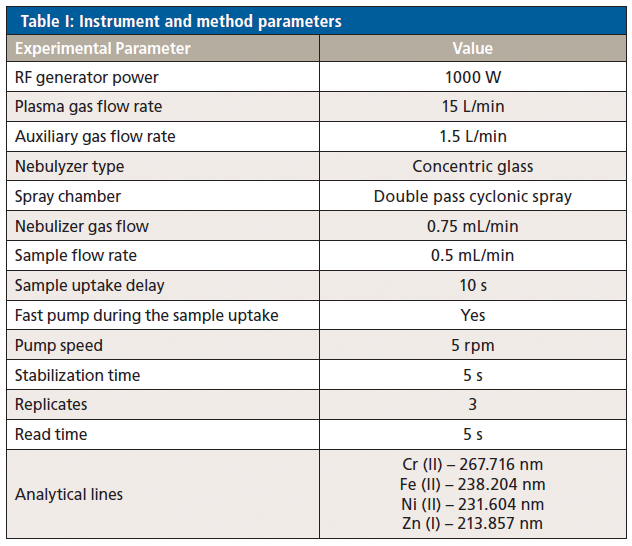
Calibration Standards
Calibration standards were prepared at concentrations from 30.0 µg/L to 9.0 mg/L by diluting 1000 mg/L stock standards (SpecSol). After matrix effect evaluation for zinc quantification in four commercial samples, the standards were diluted in 2.0% HNO3 solution, produced with deionized water with resistivity ≥18.2 MΩ cm (obtained from a Millipore Milli-Q system), for dilution of 65% HNO3 obtained from Sigma Aldrich. Quantification of chromium, iron, and nickel in metal migration studies was performed by "matrix-matched" calibration, and the standards were diluted in a solution containing 20% of a chromium-, iron-, nickel- and zinc-free mouthwash and 2.0% HNO3, prepared as described above.
Calibration Strategies and Matrix Effect Evaluation
Calibration curves were constructed in three ways: 1) external calibration (2.0% HNO3 media); 2) matrix-matched calibration in 20% chromium-, iron-, nickel- and zinc-free mouthwash (standards contain mouthwash diluted fivefold); and 3) matrix-matched calibration in 0.4% rinse chromium-, iron-, nickel-, and zinc-free mouthwash (standards contain mouthwash diluted 250-fold). Angular coefficients of the calibration curves (n = 3 for each curve) were statistically compared by Student's t-test, at a 99% confidence level, to detect significant differences in their angular coefficients and the consequent matrix effect. The mouthwash used to prepare the standards was previously diluted fivefold in 2.0% HNO3 solution, and the analytical signals obtained for the elements of interest were comparable to the analytical blank (2.0% HNO3).
Studies on Metal Migration from Stainless Steel
Stainless steel 316L samples 1.0 mm thick and 5.0 mm wide were immersed in hexane for 5 min to remove oils and greases. Next, the samples were rinsed with water, then rinsed with absolute ethanol. Finally, samples were dried at room temperature.
To evaluate the possible migration of iron, chromium, and nickel from stainless steel to the mouthwash, approximately 0.350 g stainless steel segments were added to 24 polypropylene tubes (one segment per tube), which were divided into 2 groups of 12 tubes. To the first group was added 3.0 mL of a mouthwash containing zinc salts in its composition, and to the second group was added 3.0 mL of a similar mouthwash, but zinc-free.
Tubes with mouthwashes and stainless steel segments were stored at room temperature, and were manually shaken for 5 min every 12 h for a total of 7 days. After 1, 3, 5, and 7 days of contact with stainless steel, 1.50 mL aliquots (n = 3 for each contact time) were removed from the tubes, acidified with 0.50 mL of 2.0% HNO3 and refrigerated for subsequent ICP-OES analysis.
Results and Discussion
Matrix Effect Evaluation
It is usual to perform acid digestion for elemental determinations by spectroscopic techniques in pharmaceutical and cosmetic samples (10,11). Mouthwash contains substances (such as surfactants, preservatives, and saline compounds) that change the sample's surface tension, viscosity, and, consequently, transport efficiency in the ICP-OES nebulization system (12), besides conferring high carbon levels in the matrix, which is undesirable in ICP-OES analysis. Methods that circumvent the difficulties of the matrix effect without performing acid digestions are interesting for routine analysis and increase the analytical frequency.
Table II shows the angular coefficients obtained in the external calibration and matrix-matched calibrations containing 0.4% and 20% iron-, chromium-, and nickel-free mouthwash and the Student's t-value calculated for a 99% confidence level.
There are no significant differences between the angular coefficients of the EC and MM0.4 curves; therefore, for the analysis of a mouthwash with a dilution of 250-fold, external calibration can be used because there is no significant matrix effect on the analytical signals of chromium, iron, nickel, and zinc. The comparison between EC and MM20 angular coefficients shows statistically significant differences, evidenced by the calculated Student's t-values, which are much higher than the critical value (4.604) for all analytes. Thus, for the analysis of a mouthwash with a dilution of fivefold, external calibration cannot be used because the matrix effects are significant. The lower angular coefficients of MM20 in relation to EC indicates that the mouthwash matrix, if present in high concentrations, promotes suppression of the analytical signals of chromium, iron, nickel, and zinc.
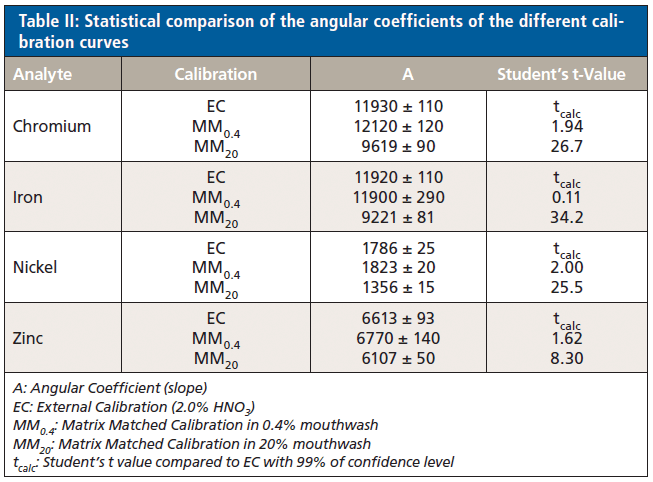
Recovery Test
To evaluate the accuracy of the proposed method, 1.0 mL of a stock solution containing 1000 mg/L of chromium, iron, nickel and zinc was diluted in a 20 mL solution of iron-, chromium-, nickel-, and zinc-free mouthwash. Then 40 µL of this solution was diluted in 10 mL of 2.0% HNO3 solution. Next, the solution was analyzed (n = 3) using external calibration. Recoveries are shown in Table III.
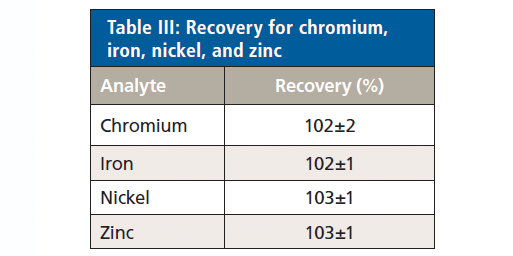
Quantification of Metal Migration from Stainless Steel
The literature reports migration tests in which samples are immersed in different corrosive media, such as artificial saliva, mouthwash, and saline solutions (7,13,14). Usually, the evaluation of corrosion is verified by microscopy.
To quantify chromium, iron, and nickel, the MM20 calibration was adopted. 1.0 mL of each previously acidified sample was diluted in 5.0 mL of 2.0% HNO3 solution and analyzed by ICP-OES. Figure 1 shows the variation in iron, chromium, and nickel concentrations (Cmetal) as a function of contact time in mouthwashes containing (a) zinc salts and (b) zinc-free.
After the first day of contact, migration of chromium, iron, and nickel to the mouthwashes occurs. Chromium and nickel concentrations did not significantly change over the 7 days of testing for either evaluated formulation.
Iron concentration in mouthwash containing zinc salts shows an increase between the 5th and 7th days (Figure 1a), but the values do not differ significantly at a 99% confidence level according to the Student's t-test (tcalculated = 2.216 and tcritical = 4.604). Also verified was an increase in iron concentration in the zinc-free mouthwash on day 5 (Figure 1b), but there was no significant difference between concentrations on days 5 and 7 at a confidence level of 99% (tcalculated = 1.040 and tcritical = 4.604).
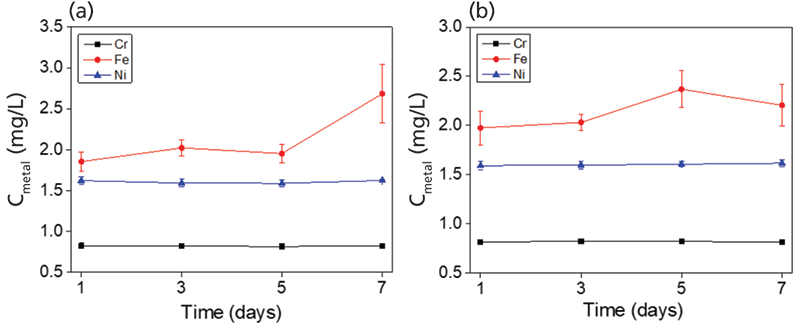
Figure 1: Fe, Cr, and Ni concentrations (Cmetal) as a function of contact time in mouthwash samples containing (a) zinc salts, and (b) zinc-free.
Limits of detection (LODs) for chromium, iron, and nickel were 16.0, 23.0 and 5.0 µg/L, respectively, calculated according to the expression LOD = 3s/a, where "a" is the angular coefficient of the curve MM20 and "s" is the standard deviation of 10 measurements of an analytical blank. The LOQ of 30.0 µg/L for all evaluated elements was estimated as the lower linearity limit of the respective calibration curves. The mouthwash used in the migration test was previously diluted fivefold in 2.0% HNO3 solution, and the analytical signals obtained for chromium, iron, and nickel were comparable to the blank (2.0% HNO3). The results shown in Figure 1 cannot be used to affirm any contamination of the mouthwash by these metals. As a result, a more rigorous migration test would be necessary.
Zinc Quantification in Commercial Samples
Four mouthwash samples containing zinc salts in their formulations were purchased in the local market, and zinc quantification was performed using external calibration. 40 µL of each sample was diluted in 10 mL of 2.0% HNO3 solution and analyzed by ICP-OES (n = 3). Results are shown in Table IV.
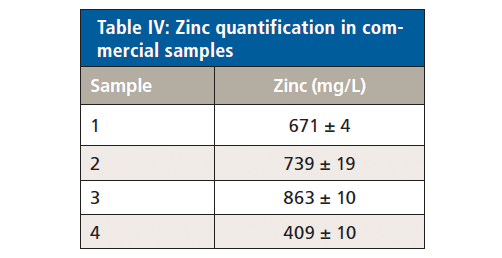
Detection and quantification limits for zinc were 5.0 µg/L and 30 µg/L, respectively, also calculated as described in the previous section "Quantification of Metal Migration from Stainless Steel," using the angular coefficient of the external calibration.
The amount of Zn2+ or zinc salts is not declared in most of the product labels, so it is not possible to make a comparison. The European Council (Regulation EC 1223/2009) sets 1.0% (by mass) as the maximum zinc content allowed in cosmetic products.
Conclusion
Statistical evaluation of the angular coefficients of calibration curves based on the Student's t-test allowed us to evaluate the matrix effects in the elemental analysis of mouthwash and guided the strategies to minimize these effects. The simple 250-fold dilution of the mouthwash samples was sufficient for zinc determination in commercial samples using external calibration, and matrix-matched calibration made it possible to quantify chromium, iron, and nickel at low concentrations while eliminating the matrix effect, simply and quickly, highlighting the small dilution factor. Excellent recovery percentages, low LODs and LOQs, and a wide calibration range for all evaluated elements show that simple strategies can be employed for elemental analysis in complex matrices, using ICP-OES.
Acknowledgments
The authors are grateful to the Multiuser Central Facilities (UFABC) for experimental support.
References
(1) P. Boyle, A. Koechlin, and P. Autier, Oral Dis. 20(Suppl. I), 1–68 (2014).
(2) A. Young, G. Jonski, and G. Rölla, Int. Dent. J. 53, 237–242 (2003).
(3) E.G. Winkel, S. Roldan, A.J. Winkelhoff, D. Herrera, and M. Sanz, J. Clin. Periodontol. 30, 300–306 (2003).
(4) S. Saad, J. Greenman, and H. Shaw, Oral Dis. 17, 180–186 (2011).
(5) J.R. Cortelli, M.D.S. Barbosa, and M.A. Westphal, Braz. Oral Res. 22(Spec. Iss. 1), 44–54 (2008).
(6) H. Kerosuo, G. Moe, and E. Kleve, Angle Orthod. 65, 111–116 (1995).
(7) G.S. Dolci, L.M. Menezes, R.M. Souza, and B.A. Dedavid, R. Dental Press. Ortodon. Ortop. Facial. 13, 77–84 (2008).
(8) A.T. Erdogan, D. Nalbangtil, F. Ulkur, and F. Sahin, Angle Orthod. 85, 665–672 (2015).
(9) W.B. Jones, G.L. Donati, C.P. Calloway Jr., and B.T. Jones, Anal. Chem. 87, 2321–2327 (2015).
(10) G. A. Zachariadis, and E. Sahanidou, Cent. Eur. J. Chem. 9, 213–217 (2011).
(11) F. C. Pinheiro, A.I. Barros, and J.A.A Nóbrega, Anal. Chim Acta 1065, 1–11 (2019).
(12) J.L. Todolí, L. Gras, V. Hernandis, and J. Mora, J. Anal. At. Spectrom. 17, 142–169 (2002).
(13) J. Porcayo-Calderon, M. Casales-Diaz, V.M. Salinas-Bravo, and L. Martinez-Gomez, Bioinorg. Chem. Appl. 2015, 1–14 (2015).
(14) D. Nalbantgil, F.Ulkur, G. Kardas, and M. Culha, Bio-Med. Mater. Eng. 27, 539–549 (2016).
P. M. F. Camargo Filho, J. F. S. Joca, and I. Gaubeur are with the Molecular and Atomic Spectroscopy Laboratory at the Universidade Federal do ABC (UFABC), in Santo André, Brazil. Direct correspondence to: ivanise.gaubeur@ufabc.edu.br

High-Speed Laser MS for Precise, Prep-Free Environmental Particle Tracking
April 21st 2025Scientists at Oak Ridge National Laboratory have demonstrated that a fast, laser-based mass spectrometry method—LA-ICP-TOF-MS—can accurately detect and identify airborne environmental particles, including toxic metal particles like ruthenium, without the need for complex sample preparation. The work offers a breakthrough in rapid, high-resolution analysis of environmental pollutants.
Trending on Spectroscopy: The Top Content of 2024
December 30th 2024In 2024, we launched multiple content series, covered major conferences, presented two awards, and continued our monthly Analytically Speaking episodes. Below, you'll find a selection of the most popular content from Spectroscopy over the past year.